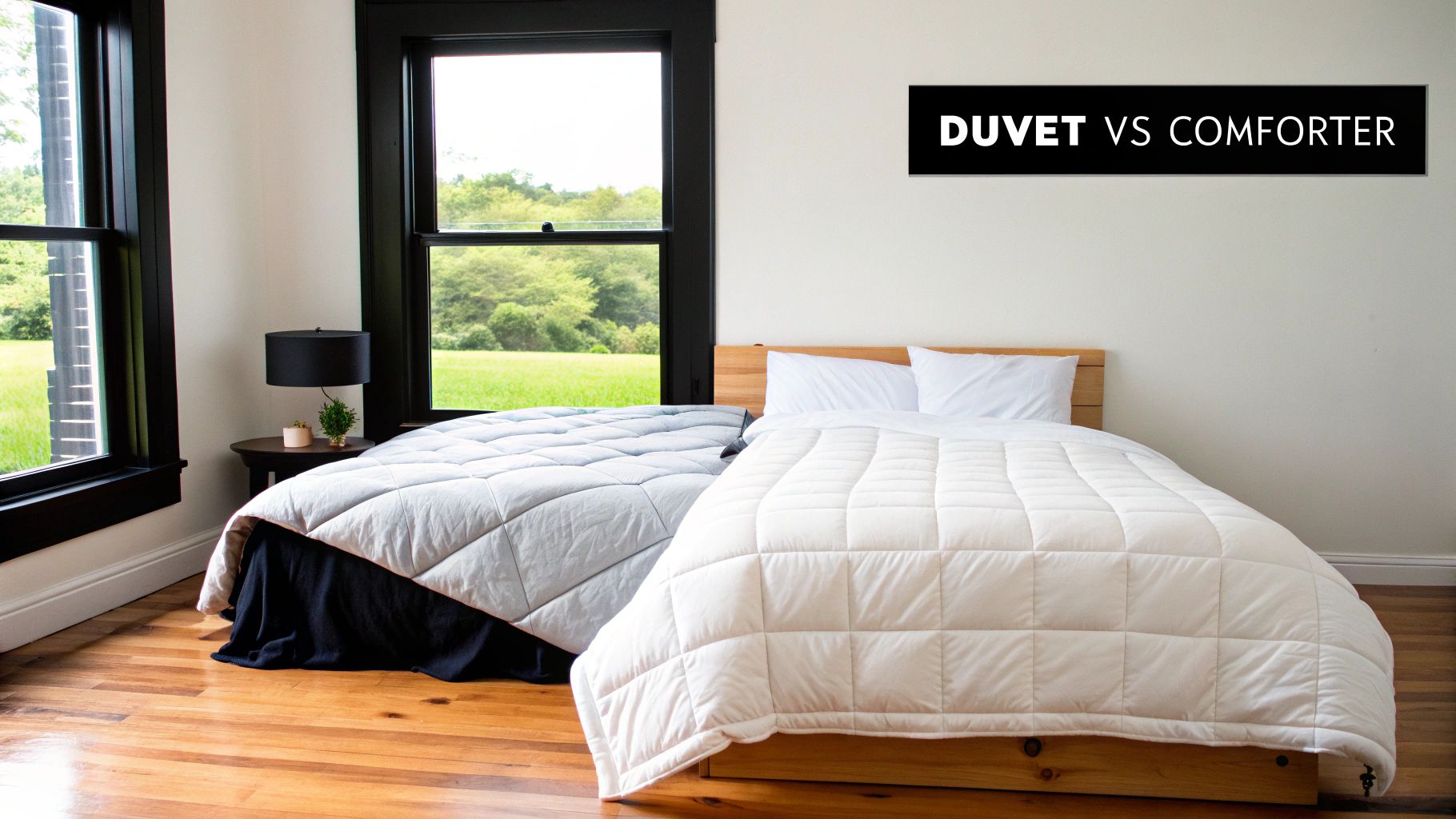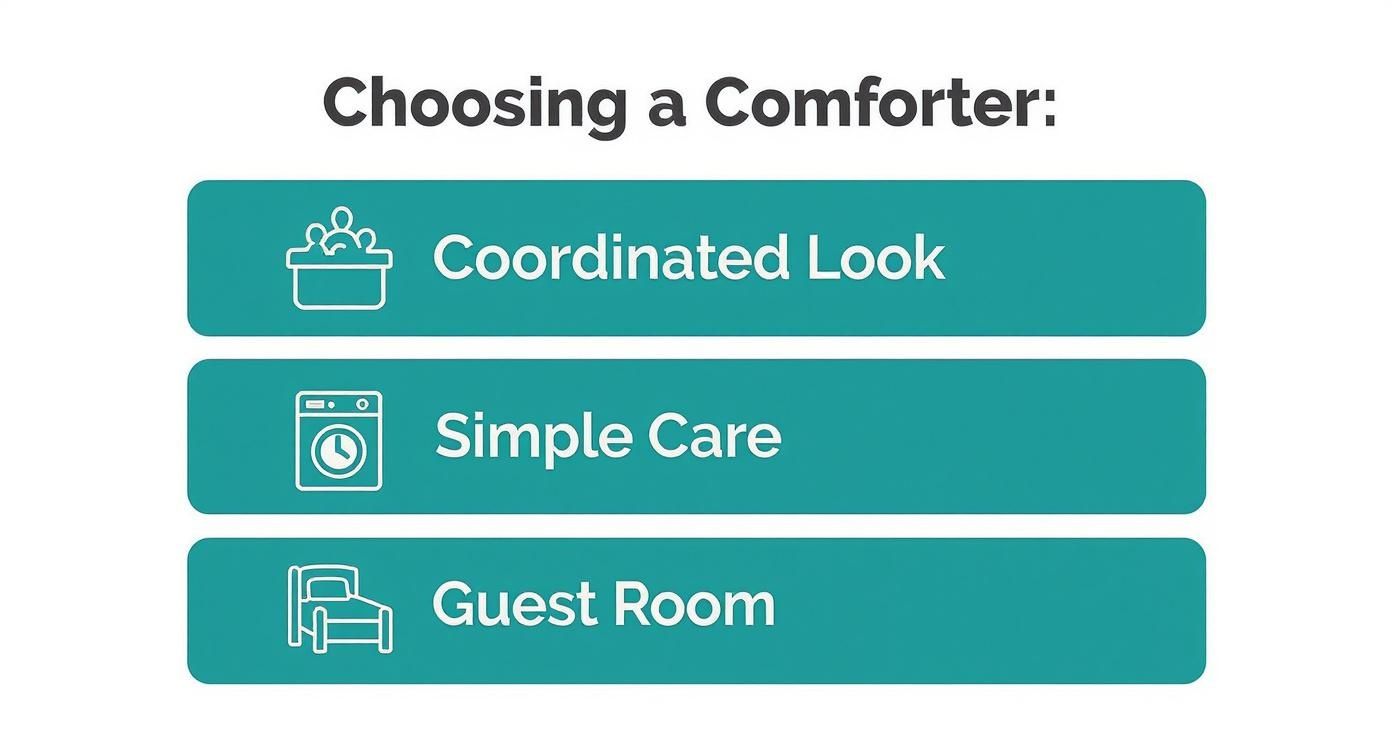Trying to decide between a comforter and a duvet? The easiest way to think about it is this. A comforter is a single piece of bedding, a quilted, filled blanket that is ready to use straight from the bag. A duvet, on the other hand, is a two part system, a plain, filled insert that slips inside a separate, decorative cover. Think of it like a pillow and its pillowcase.
This simple difference shapes everything else, from how you do your laundry to how easily you can give your bedroom a fresh new look.
Duvet vs Comforter Uncovered
Choosing the right bedding can feel surprisingly complicated, but it really comes down to what you value most. Are you looking for simple, grab and go convenience, or do you want effortless style changes and easier cleaning?
A comforter offers pure convenience, often sold in sets for a perfectly coordinated look straight away. A duvet, however, gives you brilliant versatility and makes laundry day much simpler. Let's break down the main distinctions to make your choice clearer.
Key Differences at a Glance
This quick summary highlights what sets a comforter and a duvet apart, so you can grasp the basics before we explore the details.
| Feature | Comforter | Duvet and Cover |
|---|---|---|
| Construction | A single, stitched piece with built in filling. | A two part system: a separate insert and a cover. |
| Ease of Washing | The entire piece needs washing, often requiring a large capacity machine. | Only the cover needs regular washing, which is far more convenient. |
| Style Versatility | The style is fixed. A new look means a new comforter. | Change the cover for an instant, affordable style refresh. |
| Best For | People who value convenience, simplicity, and a layered look. | People who love easy style updates, need frequent washing, and prefer a plush, fluffy bed. |

This simple comparison is just the starting point. As we explore further, you can learn more about how a duvet and its components work together to create a bed that’s both cosy and chic.
Understanding the Versatile Duvet
Chances are, you've slept under a duvet. It's a staple in most UK homes, and for good reason. A duvet is a clever two part system, a soft, filled insert that slips neatly inside a separate cover. This simple design is its greatest strength, offering a blend of practicality and style that is hard to match.

The biggest benefit comes on laundry day. Instead of trying to cram a bulky quilt into your washing machine, you just whip off the lightweight cover and pop it in with your sheets. This makes it incredibly easy to keep your bed fresh and hygienic, which is a major reason duvets are so popular.
Customising Your Comfort and Style
Beyond being easy to clean, the duvet system is all about making your bed your own. Because you can swap the covers, you can give your bedroom a whole new look in minutes. You might choose a crisp white cotton cover for summer and then switch to a cosy, brushed flannel when winter arrives, all without having to buy a completely new quilt. Our guide explains more about what duvets and covers are and how they pair up.
This flexibility also applies to the duvet insert itself. You can choose from different fillings to get the exact feel you want.
- Natural Fillings: Goose or duck down provides that classic, cloud like luxury and exceptional warmth without the weight.
- Synthetic Fillings: For those with allergies, hypoallergenic microfibre fillings are a brilliant alternative, offering plenty of cosy warmth and easy care.
A key feature of duvets in the UK is the ‘tog’ rating. This simple number, usually from 2.5 to 15, tells you exactly how warm the duvet will be. This allows you to choose a lightweight option for summer and a much warmer one for winter, ensuring perfect comfort all year round.
The widespread appeal of this system is undeniable. In fact, the duvet market in the UK is a huge part of the European bedding industry, which is projected to grow to US$2.64 billion by 2032. It’s a testament to our shared love for this practical and stylish bedding solution.
The Straightforward Appeal of a Comforter
Think of a comforter as your bed’s all in one solution. It's a single, quilted piece where the filling is already stitched inside a decorative outer shell. This means it’s ready to use straight from the packaging, so no fiddling with covers or inserts is required. Its greatest advantage is this built in simplicity.
This is exactly why you often see comforters sold in "bed in a bag" sets. These bundles typically include matching pillow shams and sometimes a full sheet set, offering an instantly coordinated bedroom with zero fuss. If you're after a polished look without the effort of mixing and matching different elements, it’s a brilliant option.
Designed for Simplicity and Consistent Warmth
A comforter is designed to provide easy, reliable comfort. The stitch patterns you see aren't just for decoration, they play a vital role in keeping the filling evenly distributed.
- Baffle Box Construction: This popular design uses a grid of stitched squares, ensuring the filling stays put in its little pocket. The result is no cold spots and consistent warmth all over.
- Channel Stitching: Long parallel rows are stitched down the length of the comforter, which creates a clean, contemporary feel while stopping the fill from shifting to one end.
A comforter’s all in one design means you get a reliable layer of warmth night after night, without any adjustments. It's an excellent choice for guest rooms, kids' bedrooms, or anyone who just wants a tidy, layered bed that’s always ready.
The demand for this kind of convenience is growing right here in the UK. The entire UK bed and bath linen market was valued at roughly USD 5.44 billion, and it's projected to climb towards USD 7.50 billion by 2030. A big part of that growth comes from the popularity of easy to buy, stylish home textiles online. To see just how much a simple yet fluffy white comforter can transform a space, have a look at our style guide.
A Practical Comparison for Your Home
When you're trying to decide between a comforter and a duvet, it really comes down to how you live. Instead of a dry list of features, let's look at the practical side of things, what really matters day to day, from laundry routines to the next time you feel like redecorating.
Ease of Care and Cleaning
When it comes to washing, the difference is huge. A duvet cover slips off and goes right into the wash with your sheets, making it incredibly easy to keep your bedding fresh. This is a real game changer if you have children or pets, as you can maintain a hygienic bed with no fuss at all.
A comforter, on the other hand, is one large, bulky item. Many are simply too big for a standard home washing machine, which often means a trip to the launderette. That extra time and expense can add up.
This infographic neatly sums up why a comforter’s simplicity might be the winning factor for you.

As the visual guide shows, if you’re after a coordinated look and straightforward setup, especially for a guest room, a comforter is a fantastic, no nonsense choice.
Style and Versatility
Your bedding is a huge part of your bedroom's look and feel, and this is where a duvet really shines. With a duvet, you can completely transform your room just by changing the cover. This gives you endless style options for a fraction of the cost of buying a whole new bedspread, letting you switch things up with the seasons or whenever you feel inspired.
A comforter offers that instant, pulled together style right out of the box. They are often sold in "bed in a bag" sets that include matching shams and cushions, which is incredibly convenient. The catch is that the design is permanent. If you decide to redecorate, you’re looking at replacing the entire comforter.
Lifestyle Comparison Comforter vs Duvet
Let's break down the practicalities of living with each option. This table focuses on the everyday factors, like washing, styling, and long term costs, that will ultimately shape your experience.
| Consideration | Comforter (All in One) | Duvet (Insert & Cover) |
|---|---|---|
| Washing Routine | Often needs a large, commercial machine. Less frequent washing is typical. | Cover is machine washable at home. Insert is washed occasionally. |
| Style Flexibility | The style is fixed. A new look means a new comforter. | Style is easily changed by swapping the cover. |
| Making the Bed | Quick and simple, just a single layer to pull up. | Takes a little more effort to align the insert inside the cover. |
| Initial Cost | Can be lower, especially with "bed in a bag" sets. | Higher initial outlay for a quality insert and a separate cover. |
| Long Term Cost | Can be more expensive if you change your decor style often. | More cost effective over time, just buy new covers to refresh the look. |
| Best For... | Guest rooms, kids' rooms, or those who value convenience and a fixed look. | Those who love to redecorate, have pets, or want easy, frequent cleaning. |
Ultimately, the best choice depends on what you prioritise. If you crave convenience and a consistent look, the comforter is a clear winner. If you value flexibility and easy cleaning, the duvet system is hard to beat.
Warmth and Comfort Control
Duvets give you much more precise control over how warm you are at night. They are sold with a tog rating, a standardised scale from around 2.5 (very light for summer) to 15 (exceptionally warm for the coldest nights). This lets you fine tune your comfort, perhaps using a light 4.5 tog in summer and swapping to a cosy 13.5 tog in winter.
Comforters are usually just labelled with general terms like lightweight, medium weight, or heavyweight. While they are certainly warm and cosy, you do not get that same level of customisation. If you're interested in how other bedding layers compare, you can read our breakdown of a comforter vs a quilt to see how they all fit together.
How to Choose the Right Bedding for You
So, after looking at all the details, which one actually belongs in your bedroom? The right answer comes down to your lifestyle, your home, and what you really want from your bedding. It becomes a lot clearer when you think about it in real world terms.
If you’re the kind of person who loves to redecorate or just switch things up with the seasons, a duvet is your perfect match. Being able to swap a light, floral cover for a rich, velvety one is a simple and affordable way to completely transform your space. This sheer versatility is a huge part of why duvets are so popular across the UK.
Making the Practical Choice
On the other hand, if you put a high value on simplicity and pure convenience, a comforter is a fantastic solution. It is the ideal choice for a guest room you need to get ready in a hurry, or for a child's bedroom where a no fuss, all in one layer makes life easier for everyone. There's no wrestling with covers, you just pull it up and the bed is made.
Think about your daily routine and storage. Do you suffer from allergies and need to wash your bedding often? An easily removable duvet cover is far more practical. Is cupboard space limited? A few duvet covers take up a fraction of the room needed to store multiple bulky comforters.
This practical difference also influences buying habits here in the UK. Market trends show duvets often taking the lead in the luxury and hotel sectors, thanks to their customisable style and superior insulation. Meanwhile, comforters appeal to those after a ready to use bedding solution for the home. You can see more on these consumer trends in the UK bed linen market.
Ultimately, your choice is also about the feel you're after. If you dream of sinking into a fluffy, cloud like bed, a high quality duvet insert will give you that exact experience. If you prefer a slightly flatter, more structured layer that still feels wonderfully cosy, a comforter is the way to go. Of course, the perfect bedding isn't complete without the right sheets, and you can explore the best bed sheet materials to build your ideal sleep setup. By thinking through these personal preferences, you can confidently pick the bedding that truly fits your life.
Common Bedding Questions Answered
To help you feel completely confident in your choice, let's clear up a few final questions about comforters and duvets. Getting these details straight is often the last step toward creating your perfect bed.
Can You Put a Duvet Cover on a Comforter?
While you technically can, it’s not usually a good idea. Comforters are often puffier and lack the corner ties that duvets have, meaning they will bunch up and shift around inside a cover. It usually ends up being a lumpy, frustrating experience.
A proper duvet insert is designed specifically to pair with a cover, giving you that smooth, secure fit that stays perfectly in place.
What Exactly Is a Duvet Insert?
A duvet insert is the inner, filled part of a duvet. It's the plain, soft quilt, usually filled with down or synthetic fibres, that slips inside a decorative duvet cover. The easiest way to think of it is as the 'pillow' to the duvet cover's 'pillowcase'.
Is a Comforter or a Duvet Warmer?
One is not automatically warmer than the other, it all comes down to the filling and its construction. The real advantage of a duvet, however, is the tog rating, a UK standard that tells you exactly how insulating the filling is.
This system lets you choose a lightweight 4.5 tog for summer and switch to a toasty 13.5 tog for deep winter. Comforters tend to be sold with more general labels like 'lightweight' or 'all season', which offers far less precision. For truly customisable warmth throughout the year, a duvet is the more practical choice.
The key takeaway is that a duvet system offers far more control and flexibility. From precise warmth levels to effortless style changes, it is designed for a personalised sleep experience that adapts to your needs.
Ready to find the perfect blend of style, warmth, and convenience? Explore the luxurious Snuggle Comforters at Morgan and Reid, designed to bring modern comfort and effortless style to your home. Discover your new favourite bedding at https://www.morganandreid.com.



Share:
Choosing the Best Fabric for a Duvet Cover
What is Cotton Sateen? A Guide to Silky Soft Bedding